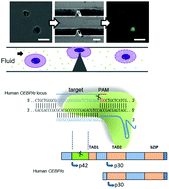Highly efficient genome editing of human hematopoietic stem cells via a nano-silicon-blade delivery approach†
Abstract
Recently, the clustered regularly interspaced short palindromic repeats (CRISPR)–Cas9 bacterial immunity system has opened a promising avenue to treat genetic diseases that affect the human hematopoietic stem cells (HSCs). Therefore, finding a highly efficient delivery method capable of modifying the genome in the hard-to-transfect HSCs, combined with the advanced CRISPR–Cas9 system, may meet the challenges for dissecting the hematologic disease mechanisms and facilitate future clinical applications. Here, we developed an effective HSC-specified delivery microfluidic chip to disrupt the cell membrane transiently by inducing rapid mechanical deformation that allowed the delivery of biomaterials into the cytoplasm from the surrounding matrix. Compared with the previous designs, the new nano-silicon-blade structure was specifically optimized for HSCs. Using the silicon substrate, the sharpness and rigidity of the nano-blade constriction was largely enhanced to improve the biomaterials delivery efficiency. We achieved highly efficient delivery results by transporting various macro-molecules into the HSCs. Moreover, the treated HSCs possess high viability and maintain inherent pluripotency after the delivery via the Nano-Blade Chip (NB-Chip). Subsequently, we disrupted the p42 isoform in C/EBPα on the NB-Chip and induced HSCs into a myeloid proliferation behavior. In conclusion, the NB-Chip provides a harmless, rapid and high-throughput gene editing approach for the HSC study and therapeutics.



 Please wait while we load your content...
Please wait while we load your content...